

SORGHUM WEBWORM and CORN EARWORMS
feeding on grain sorghum heads;
GRASSHOPPERS, HORNWORMS, and BUDWORMS are late season tobacco feeders;
GREEN STINK BUGS feeding on soybean pods;
check late-planted corn fields for damaging CORN BORER INFESTATIONS;
CRICKETS and other ACCIDENTAL INVADERS along foundations;
FRUIT FLIES in fruits and vegetables


 After our initial flush of blue mold back in the middle of August, no new reports of the disease have surfaced. As you might imagine, the hot and dry weather and the advanced stage of much of KY's crop have gone a long way in keeping old blue in check.
After our initial flush of blue mold back in the middle of August, no new reports of the disease have surfaced. As you might imagine, the hot and dry weather and the advanced stage of much of KY's crop have gone a long way in keeping old blue in check.
The threat from blue mold at this time remains fairly low in KY. The weather for the next 10 days appears to be more of what we've seen for the past 2-3 weeks - hot and very dry. The majority of the crop in KY has moved into the low-risk category, meaning that it has been topped or (more than likely) harvested. Growers with susceptible tobacco in the field should keep an eye on things; however, at this time no preventive actions are warranted. If blue mold is found in counties outside Shelby, Henry, and Oldham, please contact me (kwseebold@uky.edu).
Heat and drought have slowed other disease problems as well. Two weeks ago, we saw an increase in the amount of target spot and frogeye, but are now seeing these problems wane in the face of unfavorable conditions. At this point in the season and given the current weather, it is unlikely that fungicide applications would be needed for the majority of our producers to cope with either target spot or frogeye.
For the latest blue mold status and other tobacco disease information, check the KY Blue Mold Warning System online.
![]() http://www.uky.edu/Agriculture/kpn/kyblue/kyblue.htm
http://www.uky.edu/Agriculture/kpn/kyblue/kyblue.htm

For more information about tobacco pests, visit "Insect Management Recommendations".

I've heard reports of scattered cases of field corn with very high incidences of brown spot in western Kentucky (up to 80% of plants affected). Typical symptoms of the disease are shown in Figure 1.
In situations of high incidences like this, I believe the disease is generally a minor player in terms of yield, and field research seems to support this conclusion. However, selected cases of highly susceptible lines may show unusually high levels of damage.
Reports are that the disease is occurring above the ear in corn fields treated with QoI (=strobilurin) fungicide (HeadlineŽ fungicide, in the case I am aware of). HeadlineŽ is labeled for brown spot control, but the presence of abundant symptoms above the ear suggests that the application was not highly effective.
Except in unusual cases, I don't expect this disease to seriously impact yields. If symptoms are seen on the lower stalk after stripping away leaf sheaths, if would be good to monitor those fields for stalk strength as the crop matures and before harvest, since it is possible that lower stalk infections could compromise stalk strength in some cases. Check stalk strength by squeezing the affected stalk internode between thumb and forefinger to see if it collapses. If 10-15% of stalks collapse easily, schedule the field for early harvest before a strong wind results in lodging of the field.
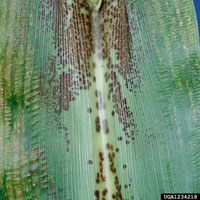
Figure 1. Symptoms of brown spot of brown spot of corn. Courtesy Clemson University - USDA Cooperative Extension Slide Series, , Bugwood.org.
 The following article was reproduced from the electronic C.O.R.N Newsletter, Issue, 2008-28
August 25, 2008 - September 2, 2008. It was written by Peter Thomison, Pierce Paul, and Dennis Mills of The Ohio State University.
The following article was reproduced from the electronic C.O.R.N Newsletter, Issue, 2008-28
August 25, 2008 - September 2, 2008. It was written by Peter Thomison, Pierce Paul, and Dennis Mills of The Ohio State University.
The article provides a very good overview of how dry weather post-silking can increase damage from stalk rots. The only thing to add to what is written is that the fungus Diplodia maydis is one of the top causes of stalk rot in Kentucky, along with Gibberella, Fusarium, and anthracnose.
Dry Weather May Lead to Stalk Lodging Problems in Corn"
Exceptionally dry weather has plagued many corn fields since early July. Drought conditions experienced during grain fill often increase the potential for stalk rot and lodging problems in corn. When stalk rot occurs late in the season as it often does, it may have little or no direct effect on yield. Nevertheless, stalk lodging, which results from stalk rot, can have such an impact on harvest losses that many plant pathologists consider stalk rots to be the most significant yield limiting disease of corn.
For a corn plant to remain healthy and free of stalk rot, the plant must produce enough carbohydrates by photosynthesis to keep root cells and pith cells in the stalk alive and enough to meet demands for grain fill. When corn is subjected to severe drought stress, photosynthetic activity is sharply reduced as leaves roll tightly and plant growth slows. As a result, the carbohydrate levels available for the developing ear are insufficient. The corn plant responds to this situation by removing carbohydrates from the leaves, stalk, and roots to the developing ear. While this "cannibalization" process ensures a supply of carbohydrates for the developing ear, the removal of carbohydrates results in premature death of pith cells in the stalk and root tissues, which predisposes plants to root and stalk infection by fungi. Even mild, early season water stress during the pretassel stage of development can significantly increase root infection by stalk rot fungi and result in greater stalk rot at maturity. As plants near maturity, this removal of nutrients from the stalk to the developing grain results in a rapid deterioration of the lower portion of corn plants in drought stressed fields with lower leaves appearing to be nitrogen stressed, brown, and/or dead.
Other plant stresses which increase the likelihood of stalk rot problems include: loss of leaf tissue due to foliar diseases (such as gray leaf spot or northern corn leaf blight), insects, or hail; injury to the root system by insects or chemicals; high levels of nitrogen in relation to potassium; compacted or saturated soils restricting root growth (recent flooding); and high plant populations.
Most hybrids do not begin to show stalk rot symptoms until shortly before physiological maturity. It is difficult to distinguish between stalk rots caused by different fungi because two or more fungi may be involved. Similarly, certain insects such as European corn borer often act in concert with fungal pathogens to cause stalk rot. Although a number of different fungal pathogens cause stalk rots, the three most important in Ohio are Gibberella, Collectotrichum (anthracnose), and Fusarium. For more information on stalk rot in corn, consult the OSU Plant Pathology web site "Ohio Field Crop Diseases" (http://www.oardc.ohio-state.edu/ohiofieldcropdisease/) for more details and pictures of the disease symptoms associated with these pathogens.
The presence of stalk rots in corn may not always result in stalk lodging, especially if the affected crop is harvest promptly. It's not uncommon to walk corn fields where nearly every plant is upright yet nearly every plant is also showing stalk rot symptoms! Many hybrids have excellent rind strength, which contributes to plant standability even when the internal plant tissue has rotted or started to rot. However, strong rinds are not will not prevent lodging if harvest is delayed and the crop is subjected to weathering, e.g. strong winds and heavy rains.
A symptom common to all stalk rots is the deterioration of the inner stalk tissues so that one or more of the inner nodes can easily be compressed when squeezing the stalk between thumb and finger. It is possible by using this "squeeze test" to assess potential lodging if harvesting is not done promptly. The "push" test is another way to predict lodging. Push the stalks at the ear level, 6 to 8 inches from the vertical. If the stalk breaks between the ear and the lowest node, stalk rot is usually present. To minimize stalk rot damage, harvest promptly after physiological maturity (about 30% grain moisture). Harvest delays will increase the risk of stalk lodging and grain yield losses, and slow the harvest operation.
In addition to potential stalk rot problems, mycotoxins, especially aflatoxins, are major concerns in drought-stressed corn. Under normal conditions, aflatoxin contamination is not usually a problem in Ohio, but the dry conditions experienced across the state may lead to such problems this year. Drought-stressed corn is more susceptible to infection by Aspergillus flavus, an ear mold fungus that produces aflatoxins. As the corn dries down and we get closer to harvest, producers should start checking for ear molds by stripping back the husks and examining the ears of 80-100 plants sampled from across the entire field. Ear molds tend to be higher in insect damaged fields and are much easier to identify in the field than in harvested grain.
Since not all ear molds are associated with mycotoxin contamination, it is important to properly identify ear molds before harvest in order to determine if mycotoxin will be a concern and to make adequate marketing and storage decisions. For more on ear molds and mycotoxins, including sampling and testing for toxins, visit the field crops disease website at
http://www.oardc.ohio-state.edu/ohiofieldcropdisease/Mycotoxins/mycopagedefault.htm http://www.oardc.ohio-state.edu/ohiofieldcropdisease/wheat/mycotoxin%20text2.htm
For information about corn pests, visit
"Insect Management Recommendations".


![]() Soybean aphid is present in Kentucky, make no mistake about that. Nevertheless, as of this writing, field infestations pest remain very small. Additionally, the north central region suction trap network indicates little activity in our area.
Soybean aphid is present in Kentucky, make no mistake about that. Nevertheless, as of this writing, field infestations pest remain very small. Additionally, the north central region suction trap network indicates little activity in our area.
The Kentucky Sentinel Plot system tells us the aphid is present and widely distributed. Fortunately, numbers of aphids remain very low. This is typical of what we have seen in past years in Kentucky. In addition, captures of soybean aphids in the North Central Aphid Suction Trap network in our area are non-existent. The two Kentucky traps (Princeton & Lexington), the Dixon Springs, IL trap and the Portageville, MO traps have not captured any soybean aphids as of the last reporting date. Again, this is quite typical of our area for this time of year.
These monitors indicate a very small likelihood that we will have trouble with this pest this year. On the other hand, they are not the only important facts to consider. The upper Midwest has had considerable problem with soybean aphid. Many fields have been sprayed and a significant number of fields have been treated more than once! You might want to review the regional situation on the Soybean PIPE site at: http://sbr.ipmpipe.org/cgi-bin/sbr/public.cgi (Be sure to select Soybean aphid as the site will open with Soybean Rust). Additionally, it is typical in Kentucky that soybean aphid populations will not show significant growth until the summer temperatures begin to decline. Past history tells us that the largest soybean aphid populations occur in the latter two weeks of September and the first of October. Add to this the understanding that we have a large number of late planted / double-crop fields of soybean that still have a long time before they mature.
Producers should continue to scout their soybean fields for soybean aphid and other insect pests. In fact they may expect to find larger soybean aphid populations than have been reported for the year to date. It is still quite likely that Kentucky will not see any economically important soybean aphid populations but one should keep and eye open, especially on any late maturing beans.
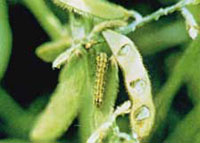 Is your corn drying down? Are your soybeans still filling pods? If so, you should be watching for the soybean podworm. This is the same insect as the corn earworm. While the pest prefers to lay its eggs on corn silks, when those begin to dry up, they will make another choice, and that choice just may be soybean pods.
Is your corn drying down? Are your soybeans still filling pods? If so, you should be watching for the soybean podworm. This is the same insect as the corn earworm. While the pest prefers to lay its eggs on corn silks, when those begin to dry up, they will make another choice, and that choice just may be soybean pods.
Soybean podworm may be the single most dangerous pest to soybean in Kentucky. Though Kentucky has very few really economically important insect infestations, the soybean pod worm is one that can sneak up and do significant damage before anyone notices its presence.
The infestation is started by adult moths laying eggs on the beans. Adults are buff to light green moths with a wingspan at rest of about ˝". The UK-IPM pheromone baited traps are beginning to show a slight increase in capture of these moths. The numbers are not out of the normal range but traditionally begin an increase at this time of year. They may bear watching over the next several weeks. You may view the counts at the end of this newsletter and at: http://www.uky.edu/Ag/IPM/ipm.htm
Eggs are white to pink and are laid singly. The eggs hatch into caterpillars that will grow to about 1" in length. The caterpillar is the damaging stage. These caterpillars are usually tan to pale green but some individuals may be almost back.
These insects feed almost exclusively on pods. They eat away pod walls and consume the seed. This also provides entry for disease organisms that may damage seeds remaining in the pods.
Plants most at risk are late planted / late maturing and late blooming plants. Also, fields with a canopy that does not close or closes very late in the season have increased risk. Additionally, fields adjacent to maturing corn will have additional risk. The adult moths are attracted into flowering plants, but the damage occurs in the pod filling stages.
For soybean in wide rows, the economic threshold is two caterpillars per row foot. This is very small number and indicates the damage potential of this pest. In narrow row beans where use of a 15"sweep net is the only available method of sampling, control should be considered if you are finding about 10 worms in 25 sweeps.
Insecticidal control is not particularly difficult. It is the detection of the pest BEFORE it has done its' damage that is most important.
For more detailed information see Entfact-144 at: http://www.ca.uky.edu/entomology/dept/entfacts.asp
For more information about soybean pests, visit
"Insect Management Recommendations".


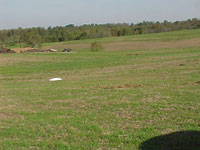 Several insects feed on late summer seedings of alfalfa and forage grasses, often without harm. However, if enough are present, there can be significant stand loss. The most common culprits are fall armyworms and grasshoppers but crickets and other insects can be there, too. Fall armyworms feed on corn, grasses, and a range of other crops. They can be active until a killing frost. Several beetle species, including the spotted cucumber beetle, feed on alfalfa seedlings. Regular inspection of new seedings will allow early detection and assessment of feeding damage, and treatment if necessary.
Several insects feed on late summer seedings of alfalfa and forage grasses, often without harm. However, if enough are present, there can be significant stand loss. The most common culprits are fall armyworms and grasshoppers but crickets and other insects can be there, too. Fall armyworms feed on corn, grasses, and a range of other crops. They can be active until a killing frost. Several beetle species, including the spotted cucumber beetle, feed on alfalfa seedlings. Regular inspection of new seedings will allow early detection and assessment of feeding damage, and treatment if necessary.
Fall armyworm infestations tend to be clumped and intense because each female can lay several hundred eggs in a mass. The small larvae move out from these focus sites as they grow and consume all of the nearby plants. Look for roughly circular areas of missing plants. Examine the soil under surface debris for the striped larvae. If caught early, spot treatments can be sufficient to deal with the problem.
Grasshoppers and crickets can chew off small seedlings. Damage may appear at the edges of fields and expand inwards. These insects will move readily so feeding should be more diffuse over an area.
Evaluate injury carefully. Low rates and spot treatments may be all that is needed to deal with pest activity. See ENT-17 for control options.


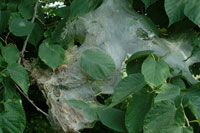 Fall webworm caterpillars are covered by pale green or yellow hairs and have rows of black spots along their backs. Groups of these caterpillars can be found in webbing at the end of branches on American elm, maples, hickory, sweetgum, and other deciduous plants. The caterpillars feed on leaves inside the webbing and expand the "tent" as they require more food.
Fall webworm caterpillars are covered by pale green or yellow hairs and have rows of black spots along their backs. Groups of these caterpillars can be found in webbing at the end of branches on American elm, maples, hickory, sweetgum, and other deciduous plants. The caterpillars feed on leaves inside the webbing and expand the "tent" as they require more food.
Usually, the infestation is limited to a branch or two on a plant and the impact is aesthetic rather
than a plant health threat. Removal and destruction of the web and caterpillars is an effective
control measure. The activity periods of this caterpillar has not coincided with MRLS.


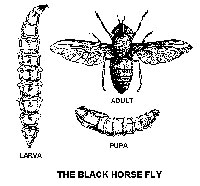 Horse flies and deer flies have painful bites! They use knife blade-like mouthparts to cut the skin, then they feed on the blood that wells up at the cut. They feed during daylight hours and are most active when winds are relatively calm. The adults are strong flies and may move as much as 2 miles from their breeding sites to feed.
Horse flies and deer flies have painful bites! They use knife blade-like mouthparts to cut the skin, then they feed on the blood that wells up at the cut. They feed during daylight hours and are most active when winds are relatively calm. The adults are strong flies and may move as much as 2 miles from their breeding sites to feed.
Horse flies are attracted at a distance by moving dark objects. When closer, they may use CO2 or warmth as cues to the host. This means they will continue to come even if insecticides or repellents are in place. They will keep trying to feed until the protectant ultimately fails and they can get in a good slice. Because of this, the flies can continue to be an annoyance even when they can't feed.
Horse fly larvae develop in moist soil along water or in wooded areas. Some species feed on insect larvae or other small invertebrates. The larvae move to drier soil to pupate before emerging as adults. The breeding sites are not only large and dispersed, they are ecologically sensitive areas that cannot be treated with an insecticide. Consequently, source reduction is not an option.
In general, horse flies don't enter darkened areas so a shady loitering area with good air flow can be somewhat of a deterrent during the day. In some cases, this may be a way that animals can get some relief.
Pyrethroid insecticides (permethrin, for example) can provide some repellent effect for animals but thorough spray coverage is needed to areas where the flies are feeding. Irritation from the insecticide can cause the fly to leave before it bites.
For more information livestock pests, visit "Insect Management Recommendations".


During the past week, the PDDL received samples of black shank, brown spot, target spot and hollow stalk on tobacco; and Fusarium blight and frogeye leaf spot on soybean.
On fruits and vegetables, we diagnosed bacterial wilt on pumpkin, Phytophthora blight and Pythium root rot on pepper; bacterial spot on tomato; and common rust on bean.
On ornamentals and turf, we have seen bacterial leaf scorch on pin and red oak; Rhizoctonia crown rot on peony; scab on pecan; southern blight on lobelia; powdery mildew on oak; dollar spot and summer patch on bluegrass; and brown patch on fescue.


August 22-29, 2008
UKREC-Princeton, KY
| Black Cutworm
| 1
| True Armyworm
| 9
| Corn Earworm
| 35
| European Corn Borer
| 1
| Southwestern Corn Borer
| 15
| Fall armyworm
| 1
| | |
Lexington, KY
| Black Cutworm
| 2
| True Armyworm
| 0
| Corn Earworm
| 25
| European Corn Borer
| 0
| Southwestern Corn Borer
| 0
| Fall armyworm
|
| | |
Graphs of insect trap counts are available on the IPM web site at - http://www.uky.edu/Ag/IPM/ipm.htm. View trap counts for Fulton County, Kentucky at - http://ces.ca.uky.edu/fulton/anr/
NOTE: Trade names are used to simplify the information presented in this newsletter. No endorsement by the Cooperative Extension Service is intended, nor is criticism implied of similar products that are not named.
Lee Townsend
Extension Entomologist